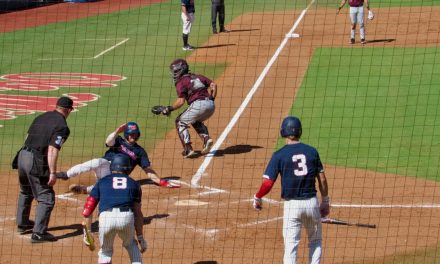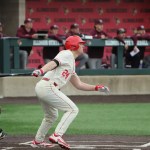Editor’s Note: As part of Homecoming, 2023 activities, Langston Rogers will receive the Honorary Alumni Award, which recognizes individuals who, though not graduates of the University of Mississippi, have consistently demonstrated extraordinary commitment, support, dedication, loyalty, leadership or service that has enriched the substance of and contributed to the advancement of the university’s or Alumni Association’s missions, reputation or prestige.
OXFORD, Miss. — Ole Miss fans pride themselves on knowing players’ names, numbers, and statistics about a player’s athletic performance. Of course, over time fans forget statistics, and the next generation of fans may have no clue what the Ole Miss athletes, coaches, and staff of the past accomplished unless a significant milestone was achieved. However, some fans love to learn about the history of Ole Miss athletics, and there are occasions when former athletes, or their family members, would like to have pictures or information about the athlete’s days as an Ole Miss Rebel. The information they seek would be lost to history if not for the archive rooms located in the Starnes Athletic Training Center, where the athletic past of Ole Miss is meticulously cataloged and preserved for posterity.
So, who would be best suited to oversee such a vast collection of game programs, news articles, pictures, and physical memorabilia? The answer is a man who has dedicated much of his adult life to Ole Miss and the athletic programs in particular, Langston Rogers. We were able to speak with Rogers and learn more about what treasures the archives hold and the expertise and commitment needed to ensure athletes and their accomplishments are not lost to the past.

Langston Rogers surveys the collection of Ole Miss athletics memorabilia.
Rogers served as Sports Information Director and was the Senior Associate Athletics Director for media relations when he retired in 2010 after twenty-nine years of service. Presently, he works part-time as a special assistant to the Athletics Director for history. Throughout 42 years, Rogers has seen a great deal of history made and has further developed a system of cataloging and maintaining athletic statistics, pictures, articles, and other memorabilia.

With this memorabilia of the legendary head coach John Vaught is the hat the Rebels’ coach wore, given to Mr. Rogers and Ole Miss by Coach Vaught’s daughter on the day of her father’s funeral.
In a world of technology, folders in filing cabinets just don’t cut it anymore. People need access to information in an easier-to-attain format. With this in mind, the archives department began the daunting task of scanning into digital format the history of Ole Miss athletics.

Family members or former players can get in touch with Langston Rogers for copies of old photos as the archives has the negatives.
Several years ago, when the scanning process began, the group who came in to help Rogers design the archives room estimated there were three million scans to complete. Three million! Needless to say, the job of scanning millions of pages and pictures is a very time-consuming task.

Langston Rogers and others are ensuring Ole Miss archives are preserved and maintained digitally.
Still, Rogers and other dedicated workers have undertaken the mission to digitally preserve every single thing they can get their hands on that deals with Ole Miss athletics.
“We have records going back to 1893. We’ve got pictures of the first team. We collect everything. I don’t throw anything away….game programs, media guides in all our sports, newspaper clippings, documents we may have, anything that we can scan because we’re moving over to doing everything digitally.”
Langston Rogers
Such a vast amount of information needs a system of cataloging that is meticulous and easily searched. Rogers explained how each person’s information is scanned into the computer and saved in a digital folder. Within the folder are subfolders specific to the item scanned.
“If I had all of the pictures of Archie (Manning) in all the different categories and they were just up on the wall, it would take forever to find things. That’s why I break it down into whatever the event was. So, if someone asks me for, let’s say, a picture of Archie when he went into the College Football Hall of Fame in 1989, I would go down to “Manning, Archie,” and see there are all these different folders. This is just an example. I’ve got thousands and thousands of pictures, and they are all backed up on the server. I can go into the different sports and find all the coaches, players, and support staff.”
Langston Rogers on the archiving process
Here is the actual summer workout Coach John Vaught gave to Archie Manning in 1968.

The summer workout Coach John Vaught gave to Archie Manning in 1968.
And here is the cast Archie wore after breaking his arm in 1970, along with an article written at the time.

The cast Archie Manning wore after breaking his arm in 1970.

An article describing Archie Manning’s surgery as well as Coach Vaught’s recovery from a heart attack at the same time Manning was hospitalized.
Not only do Rogers and others have the job of scanning documents from past years, but they also have to keep up with the more current players and coaches who graduate or leave. It’s an ongoing, never-ending process.
Rogers related, “Media guides of all the sports was our starting place. Media guides, game programs, plus the alphabetized list of former athletes, coaches, and support staff A to Z. It doesn’t matter what year they played, it’s just alphabetical. We’re doing them alphabetically that way because each year when people leave we try to make sure if it’s someone from the A’s or B’s we keep up with it because we have already been through the A’s, B’s, and C’s,” he explained.
People who aren’t history buffs may not understand why the archives of Ole Miss athletics are such a big deal, but for those who do, the archives serve as a gateway to the past. Whether it’s a former student-athlete who lost their belongings to a disaster, family members in need of information for an obituary, or fans in general who just want to know more about Ole Miss, Rogers can fill a void by providing the information they need.
“We had a player from the coast that when Camille hit, he lost everything. I was able to search and get him pictures to replace the ones he lost. You know, we gave him a piece of his history back.”
Langston Rogers
Rogers says some players may not understand the importance of the archives until they get older. Players return and stop by to visit with Rogers and relive the glory days of their student-athlete experience.
“The older you get,” Rogers explained, “the more important it becomes. You don’t think about it when you’re here at Ole Miss, but we’re trying to document each individual student-athlete, coach, and support staff, even down to the football, baseball, and basketball managers. They’ll all have a file.”
When we asked Rogers what pieces of memorabilia stood out most to him, he told us about two rather unique pieces.
The first is a bear trap with a bear tail attached which was anonymously sent to Coach Vaught after Ole Miss defeated Alabama in 1970. The plaque attached to the trap reads, “John Vaught Trapped the Bear, October 3rd, 1970, Ole Miss 43, Alabama 23.” As far as anyone knows, Coach Vaught never found out who sent the gift.

The bear trap with a bear tail attached that was anonymously sent to Coach Vaught after Ole Miss defeated Alabama in 1970. (Photo courtesy Ole Miss Athletics)
The second item of interest once belonged to former Ole Miss football player and chancellor Robert Khayat. “Back in the 50s,” Rogers recounted, “the Sugar Bowl gave the players gifts. They gave them a big piece of brown luggage with a sugar cube inside. They were big, and they had the player’s image on the sugar. It’s beginning to disintegrate, and I’ve had to spray the area because bugs get in the sugar….I just think it’s one of the most unique things out there. There’s a lot of trophies and plaques and stuff, but there’s nothing like that.”
Here’s the original picture of Robert Khayat from which the sugar cube was patterned, followed by the sugar cube.

Photo of former Ole Miss football player and former Chancellor Roberty Khayat that was used to make his sugar cube for the Sugar Bowl.

Here’s the actual sugar cube of Robert Khayat from the Sugar Bowl all those years ago.

Sugar Bowl Memorabilia
Rogers doesn’t focus only on the past but also plans for the future and a time when the history of Ole Miss athletics is right at fans’ fingertips.
“We’re scanning everything in a searchable friendly way. The goal is to put all of it online so our fans can go in and see what we have. There will be PDF files and JPEGs. It’s especially important if and when we get the museum that we want to have. Right now we just have a room of items that have been given to us, but we really haven’t called on our former student-athletes to start donating yet because we don’t have the room to store them. We will be in the situation with a new museum to change out exhibits from time-to-time….It’s going to be a major project. We’re going to need a lot of help from a lot of sources.”
Langston Rogers
For Ole Miss athletes, coaches, and staff, there is a great deal of Ole Miss Athletics history to make. Each athletic program has accomplishments and championships yet to be commemorated. Rogers and others will continue to preserve as much memorabilia as possible and document all the achievements of Ole Miss Athletics so future fans can learn of the legends of the past and dream of becoming the champions of the future.
Here are some additional photos from our visit with Langston Rogers. We appreciate his time — and his work — more than we can express.

Langston Rogers with Deuce McAllister and Romaro Miller, with their words of appreciation.

“Archie’s Army,” “Archie Who?” and other Manning buttons.

Commemorating former Rebel legend Chucky Mullins.

Photo of Steve Wilkerson. While at Ole Miss, he was captain of the Ole Miss Boxing Team and won the Southeastern Conference Boxing Championship in 1938 and 1939. He won the NCAA National Welterweight Boxing Championship at Madison Square Garden in New York City in 1939. The New York Times voted him the Outstanding Amateur Boxer in the U.S.

Liberty Bowl trophies with a replica of the bust of Frank “Bruiser” Kinard on display at the Pro Football Hall of Fame in Canton. He was the first Mississippian inducted into the Pro Football Hall of Fame.
Hotty Toddy!
Like this:
Like Loading...
Related
Donna Sprabery
Donna Sprabery is a former teacher, graduation coach, and academic coach for boys basketball. She graduated from the University of West Alabama with a major in business education and from Arkansas State University with a MA in Educational Leadership. A native of Meridian, MS, Donna enjoys traveling, gardening, writing, volunteer work, and cheering on the Rebels.





































